On 16 December 1944, the Germans launched Unternehmen Wacht am Rhein (“Operation Watch on the Rhine” AKA the Battle of the Bulge) with the objective to split the Allied armies in the Ardennes, cross the Meuse river and capture the port of Antwerp. This would have allowed the Germans to encircle and destroy the Allied armies and force the Allies to negotiate a peace treaty. The winter weather (snow and fog) concealed the German build up and grounded the Allies air power allowing the offensive to achieve a good beginning but due to strong allied resistance, the lack of fuel and then the weather clearing, the Germans were not able to achieve their main objective. The maximum distance reached by any German unit to the west was about 5 km (3.1 miles) short of the Meuse river at the village of Foy-Notre-Dame, Belgium(northwest of Celles and east of the Dinant).
The German XLVII Panzer Corps consisted of 2. Panzer-division, Panzer Lehr Division and the 26. Volksgrenadier-division. After the Volksgrenadiere had secured crossings over the Our river near Dasburg and the Clerf river at Clervaux, the 2. Panzer-division broke through the American lines, bypassed Bastogne advancing through Noville to the north and then advanced towards the Meuse river.

During the German offensive in the Ardennes, the 2. Panzer-division was divided into a number of kampfgruppens (battle groups). These two kampfgruppens reached the Celles and Foy-Notre-Dame area.
Kampfgruppe von Böhm
– 2. Panzer-Aufklärungs-abteilung (PzAufklAbt 2) including an armoured car company.
– One kompany of I. Abteilung/3. Panzer-Regiment (14 Panther Gs)
(This kampfgruppe was the advance element of the division’s attack and led the way towards the Meuse river.)
2. Panzer-Aufklärungs-abteilung vehicles (December 1944):
Stab Kompanie:
Two Sd.Kfz.232 (8 rad), two Sd.Kfz.234/1, ten Sd.Kfz.234/2 (Puma), three Sd.Kfz.233, one Sd.Kfz.250/1, one Sd.Kfz.250/9, one Sd.Kfz.251/1 and three Sd.Kfz.250/3 – three in short-term maintenance.
1st Kompanie (light half-track scout):
Detached for other duties and not reported. Officially listed as being reconstituted.
2nd Kompanie (light half-track reconnaissance):
Twenty Sd.Kfz.250/1, three Sd.Kfz.250/2, one Sd.Kfz.250/3, one Sd.Kfz.250/5 and five Sd.Kfz.250/7. Three in short-term maintenance and five in long-term maintenance.
3rd Kompanie (light half-track reconnaissance):
One Sd.Kfz.250/3 and the panzergrenadiers travelled mainly by bicycle.
4th Kompanie (heavy armored):
Two Sd.Kfz.251/1, one Sd.Kfz.251/3, two Sd.Kfz.251/7, two Sd.Kfz.251/9 and two Sd.Kfz.251/21.
Kampfgruppe Cochenhausen
– II. Bataillon/304. Panzergrenadier-Regiment
– Two kompanies of I. Abteilung/3. Panzer-Regiment (32 Panther Gs)
– I. Bataillon/74. Panzer Artillerie-Regiment (10 Wespe and 6 Hummel SPs)
– One SP Battery of 273. Flak Bataillon
– 38. Panzerpionier-Abteilung.
(This kampfgruppe followed behind Kampfgruppe von Böhm as the division’s main armour group, however, all of the panzergrenadiers were transported in trucks and due to the lack of fuel many of the trucks were towed by the panzers.)
Kampfgruppe von Böhm near Hargimont on 23 December.
Top: Puma and Sd.Kfz.233 armoured cars, Bottom: Sd.Kfz.233, Panther and Puma.
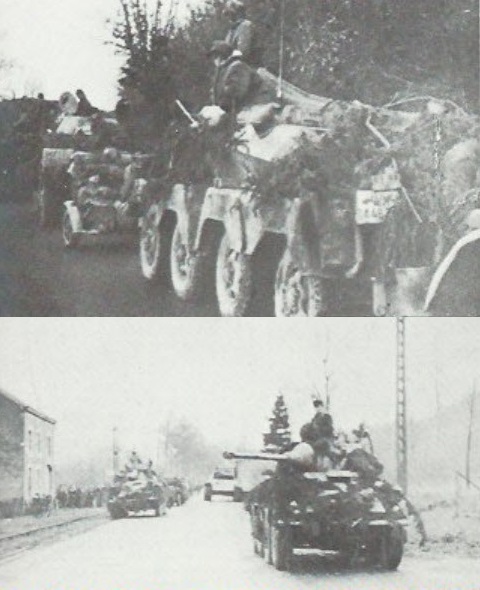
The British 29th Armoured Brigade was the armoured element of the 11th Armoured Division (XXX Corps). In early December, the brigade was taken out of the line and transferred to Ypres, Belgium to trade in their Shermans for new Comet tanks. They left all their Shermans at army depots in Brussels and only a half dozen of the new Comets had arrived when, on 20 December at 0200 hours, the brigade was alerted to immediately move to the Ardennes. The brigade’s armoured regiments left the training areas in trucks, picked up their old tanks in Brussels and then rushed to the Ardennes. By the evening of the 21st, the brigade had taken up positions along the Meuse river with the 3rd Royal Tank Regiment (3rd RTR) located at Dinant which was supported by a company of the 8th Battalion The Rifle Brigade (The Prince Consort’s Own) equipped with carriers with Area of Service (AOS) number 54 on a red square.
Around midday on 21 December, armoured cars of the 3rd RTR arrived at the Dinant bridge and took up defensive positions. The bridge was found defended by an odd formation called ‘R’ force which consisted of a number of elderly tankers with some obsolete tanks and armoured cars, a sapper force who already mined the bridge and a platoon of American GIs who were dealing with fleeing civilians and rear area personnel. If the Germans were able to advance faster and in strength, this ragtag force would have been the only unit defending one of the vital crossings on the Meuse river. At dusk, some 60 3rd RTR Shermans arrived and took up positions around Dinant on the west bank of the Meuse river. Due to the lack of air reconnaissance, the 3rd RTR sent out long range patrols east towards Marche, Belgium where they made contact with the 334th Regimental Combat Team of the US 84th infantry Division. The information gathered indicated that there was a threat to Dinant and the 3rd RTR moved two Sherman squadrons across the Meuse river and setup outposts which cover all the approaches to the bridge.
The bridge in Dinant with civilian refugees. Note the US jeep at the right edge of the photo and the GIs around the truck. Side note: Charles de Gaulle was wounded on this bridge during WWI.

The same building next to the bridge still exist today and is Cafe Leffe.
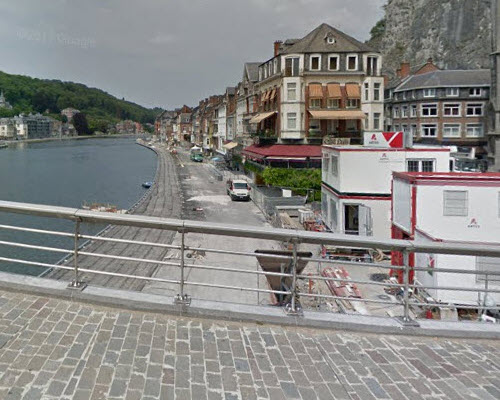
On 23 December, the weather cleared allowing the Allies air support to fly over the battlefield. Spotter planes were able provide aerial reconnaissance and direct the artillery and the Tactical Air Command were able to provide air ground support to Allied units by attacking German armor, vehicles and troops.
During the night of 23 December, Kampfgruppe von Böhm reached Foy-Notre-Dame, out of fuel. Kampfgruppe Cochenhausen followed behind and deployed in the Conjoux and Celles areas.

Around midnight of 23/24 December, a jeep with 3 Germans disguised as Americans attempted to enter Dinant. The captured jeep belonging to Otto Skorzeny’s 150th SS Panzer Brigade refused to stop for a British sentry and ran a checkpoint. The sentry fired his flare pistol alerting the next checkpoint manned by Sergeant Baldwin’s carrier section of the unknown intruder. After seeing the signal, Sergeant Baldwin executed defensive measures of pulling a string of mines across the road ahead of the speeding vehicle which resulted in the jeep and its occupants being blown up. The explosion was so great that it broke the jaw of an American standing a considerable distance away. The Germans were wearing American greatcoats over their uniforms and in their pockets were detailed plans of the Allied defenses in the area. Those Germans knew if they were captured they would most likely been executed as spies. This small band of saboteurs were the only German troops which advanced the furthest west during the Ardennes offensive.
The Rocher Bayard (“Rock Bayard”) on the east bank of the Meuse river about 1.88 km(1.17 miles) south of the bridge is a section of road which is a narrow pass carved through a mountain and was the location of the second checkpoint which was manned by Sergeant Baldwin. This view is to the south through the pass and the jeep would have been heading towards us. The carrier would had been positioned to the right of the pass and the walls of the pass would have contained the mine explosions.
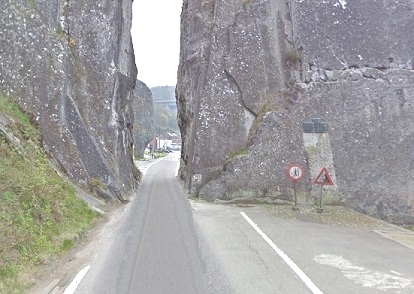
The 3rd RTR was headquartered in the Chateau of Sorinnes and the owner, Baron Jaques de Villenfagne who served in the Chasseur Ardennais of the Belgian Army and a hunter was an active local resistance fighter. Along with his cousin Phillipe le Hardy de Beaulieu, the Baron aided the 3rd RTR by performing a night reconnaissance of the area. During the night of 23/24 December while dressed all in white to blend in with the deep white frost in the area, the two men covered a few kilometers and returned seven hours later. Based on the sounds made by panzers and stray German artillery fire, they were able to create maps of the suspected German positions in the area.
These maps provided the Allies important information for directing artillery fire and air strikes on the suspected positions identified by these two brave Belgians.
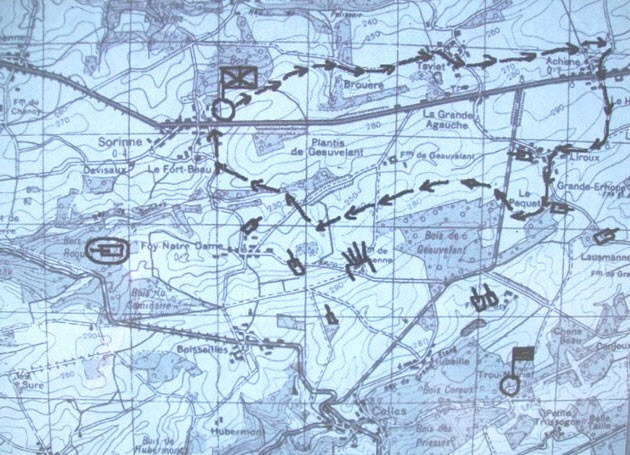
The Germans in the Conneaux-Conjoux area began to push out north, west and south just before dawn on 24 December. A German recce column moved up a hill towards Dinant with its vehicles bunched up (probably the panzers were towing trucks). Ahead of the advancing column was a 3rd RTR Sherman Firefly in a hull down position on the rise whose crew who had been on alert for three nights were all asleep. The noise of the German tank engines and tracks awoke the crew. During the initial confusion, the first 17 pdr HE shell missed the leading half-track and hit an ammo truck further down the column which exploded and set fire to a nearby fuel lorry. After becoming wide awake, the tank commander and gunner then knocked out a PzKpfw IV, the leading half-track and two more trucks before a Jagdpanther pushed pass the burning wrecks and opened fire. The tank commander quickly ordered the driver to withdraw behind the hill to avoid taking on the deadly 88mm SP. The Jagdpanther probably did not follow because its lower hull would had been exposed when it reached the crest of the hill or it ran out of fuel. sPzJgAbt (schwere Heeres Panzerjäger Abteilungen) 559 had five Jagdpanthers and was attached to the Panzer Lehr Division during the Ardennes offensive. On 30 December 1944, the 559th had 2 Jagdpanthers still combat ready, 2 in repair and 1 was lost.
A single Panther advanced the most furthest west of the entire Adrennes offensive was knocked out by the British on Christmas Eve lay forlornly in the parish priest’s garden. There is no photo or more information about this Panther.
At 0820 hours on 25 December, 16 Shermans of 3rd RTR C Squadron, a platoon from the 8th Battalion The Rifle Brigade and a section of recce troops in carriers moved south along the east bank of the Meuse and then advanced east towards Boisselles (south of Foy-Notre-Dame and northwest of Celles). The column drew fire and made a dash down a forward slope into the village losing one tank but taking it with some prisoners. Four panzers on high ground to the northeast came out of the Bois de Geauvelant and opened fire on the surrounding area. A Sherman Firefly maneuvered into position and returned fire forcing the panzers to withdraw back into the woods.
Another 3rd RTR and infantry column from Dinant moved east to Sorinnes (north of Foy-Notre-Dame). They knocked out three Panthers and some infantry near Sorinnes, then shot up more German vehicles and took prisoners around Foy-Notre-Dame and then they linked up with the 82nd Armored Reconnaissance Battalion of the US 2nd Armored Division. With forces of three nations in the area, the situation was often confusing and when the 82nd made contact with a British unit they fired upon it and destroyed a British Sherman which was advancing towards their lines. The British were then ordered to remain in place. They had ring side seats to watch the US 2nd Armored Division Combat Command B (CCB) Task Force A and the US Air Force sweep through the area towards Celles.
Task Force A with Shermans in front advanced southwest through Liroux and the Bois de Geauvelant with little opposition. As the task force emerged from the trees it came under fire from the farm east of Foy-Notre-Dame and lost three half-tracks. Air support was called and P-38s bombed/strafed four Panther tanks temporarily putting them out of action. The column again drew fire near Boisselles by the same Panthers which had earlier fired on the British. Two platoons (ten Shermans) of the US 67th Armored Regiment moved in and destroyed three Panthers. By the middle of the afternoon Task Force A reached the high ground overlooking Celles, blocking the roads to the west and southwest. Task Force B had a brief battle at Conjoux, then continued knocking out isolated panzers and guns until it arrived on the ridge 1,300 yards (1188.72 m) southeast of Celles. Kampfgruppe von Böhm and Kampfgruppe Cochenhausen had been completely cut off with no chance of rescue. Kampfgruppe Cochenhausen crews abandoned or destroyed their vehicles and retreated to the east on foot.
This is a segment of the 67th Armored Regiment, US 2nd Armored Division After Action Report (AAR) for 25 December. I have darken this page so it is more legible.
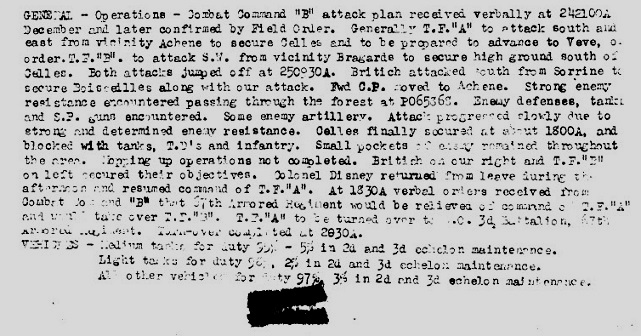
This segment of the 67th Armored Regiment AAR covers 26 December.
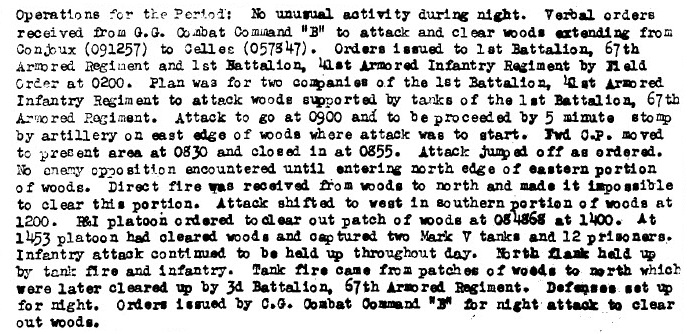
At Ferme de Mahenne (Mahenne farm) to the east of Foy-Notre-Dame, three Panthers were positioned where they dominated a road junction. The Panthers were knocked out in air attacks by P-38s of the 370th Fighter Group, IX Tactical Air Command which flew air support for US 2nd Armored Division CCB. Some sources state that 3rd RTR Shermans advancing from Sorinnes knocked out these Panthers which is incorrect. There is no photo of the fourth Panther or any information of its location.
The following two images are my close ups from IWM B 13238
This Panther is on the east side of the group facing northeast. Note the frost/snow on the tree branches behind it.

This is the center Panther facing north. Note the open driver’s hatch.

This is my close up of IWM B 13243
This is the center Panther seen from the west. Compare the open driver’s hatch to the photo above. The Panther on the right edge of the photo is facing east with its turret transversed north.

This photo is the rear of the western Panther. In the background is the center Panther in the photo above.
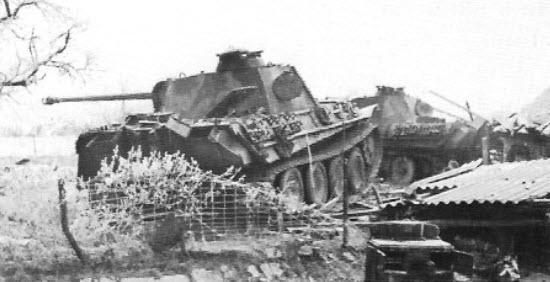
This is an overhead view of the area today. The red circle on the left is the probable location of the most western knocked out Panther in the parish priest’s garden. The red circle on the right is the location of the Mahenne farm between Foy-Notre-Dame and the Bois de Geauvelant.
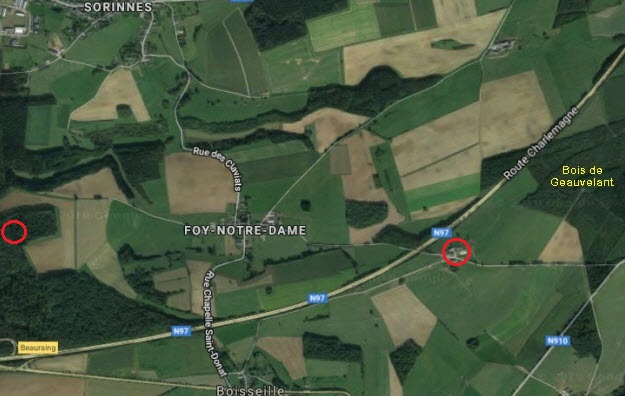
The crewman peeking out of the turret of this 3rd RTR Sherman is Lionel Whitcher who was the radio operator for the CO of 3nd RTR. This photo was taken on 25 December 1944. If the Shermans had markings, they would had the Bull formation sign of the British 11th Armoured Division and the AOS number 52 on a red square.

About mid-day on 25 December, the 82nd Armored Reconnaissance Battalion ran into remnants of the Kampfgruppe von Böhm in Foy-Notre-Dame and part of this group escaped eastward to rejoin the main force in the Bois de Geauvelant to the east. When a platoon from the 82nd moved into the village, they encountered AT and MG fire from hidden positions but were able to clear the village.
The following images are from the 82nd Armored Reconnaissance Battalion AAR for 1944. Many sections of the report are either extremely faded or blurred. These sections are readable and the most relevant.
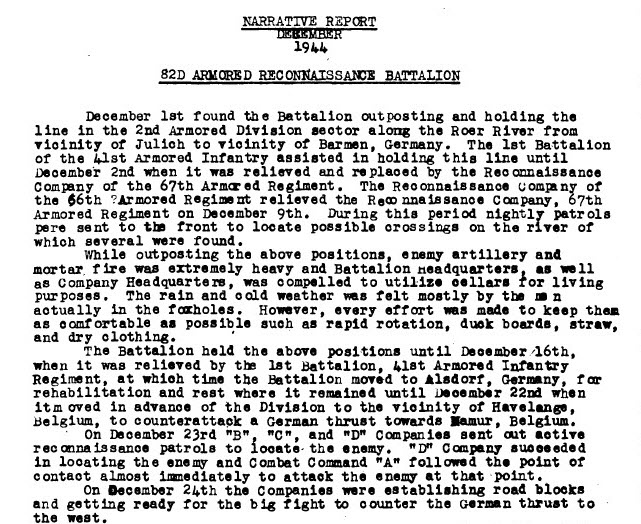

The most interesting information in the is some of the vehicles listed as captured.
“1 MK VI tank” (Tiger I ? ), “12 American 1/4 ton 4 x 4 trucks” (Jeeps), “15 volkswagens” (Kubelwagens) and “3 six wheeled armored cars” (Sd.Kfz.231 6-rad ?).
Side Note: On 12-13 May 1940, Rommel’s 7th Panzer Division reached Dinant and crossed the river after heavy fighting. Panzer-aufklärungs-abteilung 37 had several 6-rads which some could have been knocked out or abandoned in this area.
This section covers A company actions. The sections on the other companies are mostly unreadable.

This sorry looking captured US Jeep was found in Foy-Notre-Dame.
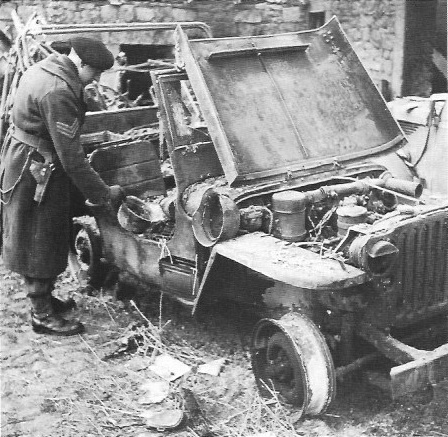
The following four images are my close ups from IWM B 13260
This photo was taken at the triangle corner at Rue de Mahene and Rue de Jauvalan in the village of Foy-Notre-Dame. The commander of this Sd.Kfz.234/2 Puma was Oberleutnant Rudolf Siebert of 2. Panzer-Aufklärungs-abteilung. A Sd.Kfz.250 is parked in front of the building. Note a ladder and a bicycle is leaning against the building. In the foreground is a camouflaged 75mm Pak 40 AT gun which could have engaged the Americans along with a panzerfaust and helmets lying on the ground around it. Between the Pak 40 gun and the Puma is a fuel trailer.

Note the tarp hoops on top of the rear compartment of the Sd.Kfz.251 Ausf. D.
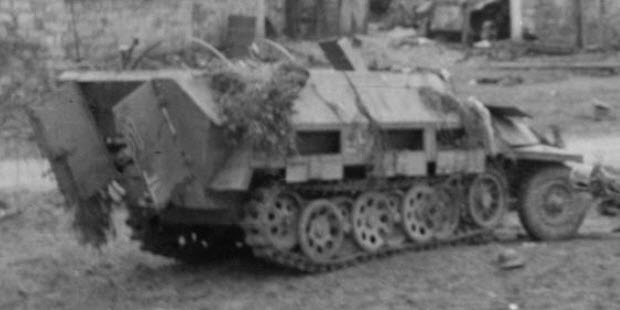
This is my close up of the vehicle rear in the lower left hand corner of the photo.
Not able to identify the vehicle type but the “B6” would indicate that it is American.
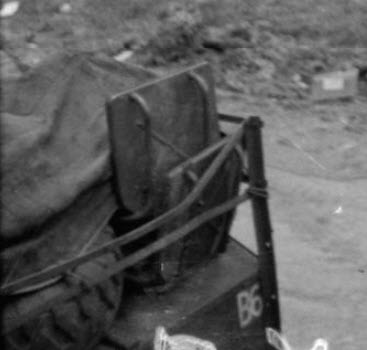
This is my close up of the vehicle in the bombed out barn or garage section of the building. Could this be the rear of a destroyed Sd.Kfz.231 6-rad or a Sd.Kfz.261?
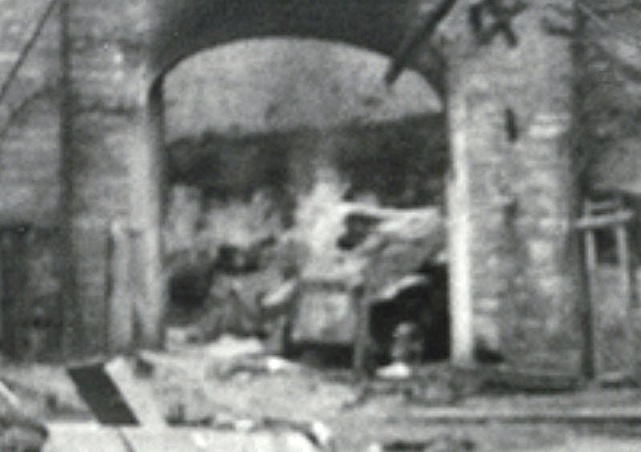
This is the location today. The bombed out barn or garage section was torn down. The small building at the left still exists. There is now a bench and a monument next to the tree.

These images are from Google Maps street view scans from October 2009. After 65 years, the tree would have grown to a fair size but it is also possible that this is not the same tree.

The knocked out and captured vehicles were taken to a collection point in a field northeast of Celles. This collection point is probably only one of several in the area. The following photos are of the equipment of the collection point being examined by British and US troops.
This Sd.Kfz.233 belonged to 2. Panzer Aufklärungsabteilung of the 2nd Panzer Division. It probably is one of the first vehicles brought to the collection point since there are no other vehicles or equipment behind it and the tow cables are attached to the front. Note the jack on the ground beside it and the jeep in the background.
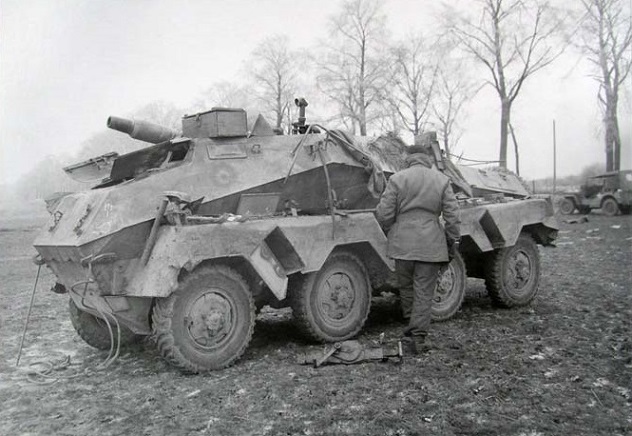
These are the markings on the front. The trident is the late war marking of the 2nd Panzer Division and below is the tactical marking for an armoured car company.
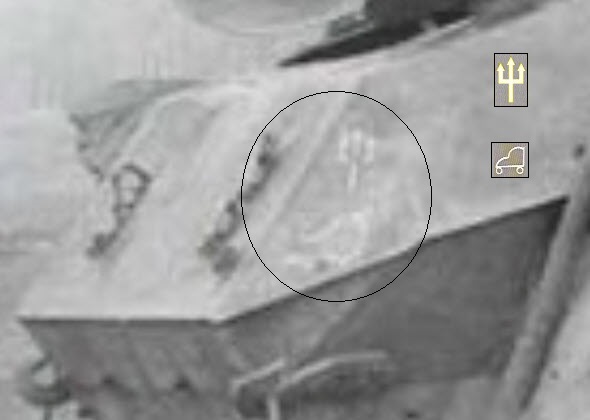
This is another view of the Sd.Kfz.233. Note in the background are two US M5A1 Stuart light tanks.
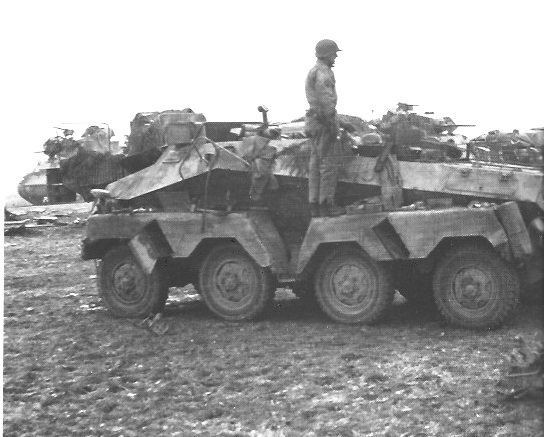
This photo shows the Sd.Kfz.233 in the line with a Sd.Kfz.234/2 Puma.
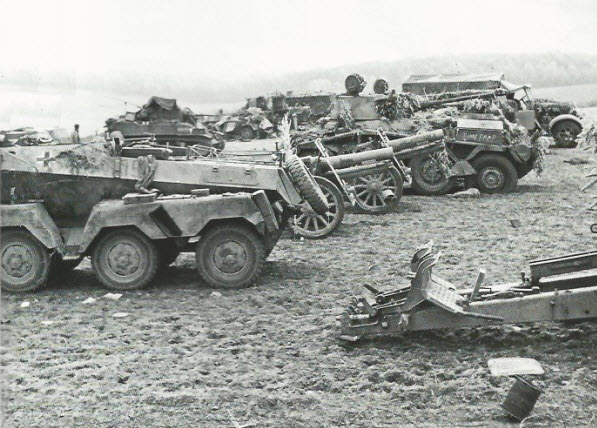
This is a close up of the Sd.Kfz.233 rear hull. Note the frame rack on the engine deck. The tactical numbers could be from another unit and were not repainted.

This photo shows two Sd.Kfz.234/2 Pumas in the line. A Kfz 17 Funkwagen (radio car) was towed to the collection point and in the background the Sd.Kfz.233 can be seen.
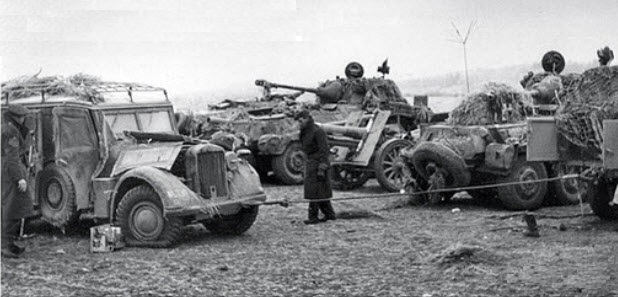
The following two photos are side views of IWM B 13253
The nearest 150mm schwere Infanterie Geschutz 33 (sIG 33) has the name “Frieda” painted on its barrel.

In the foreground of this photo is the barrel of a leichte FH18 field gun.

A Sd.Kfz.11 3 ton half-track in front of a Sd.Kfz.261.
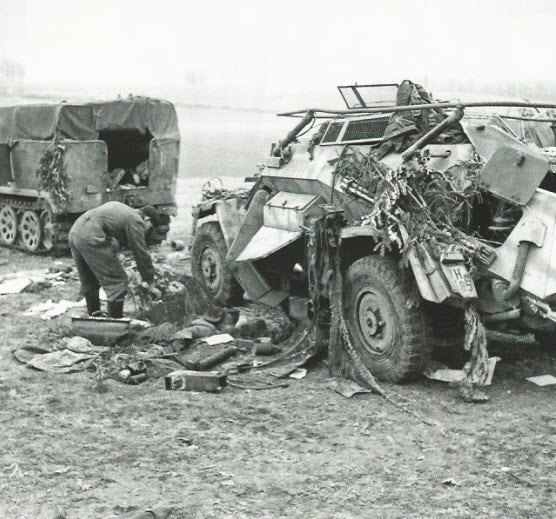
This photo shows the other side of the same Sd.Kfz.261 above. In the lower left hand corner is the hood and front grill of a Steyr Type 1500A light truck.

This is my close up of lWM B 13248
In the foreground is a Kubelwagen with the cover erected.
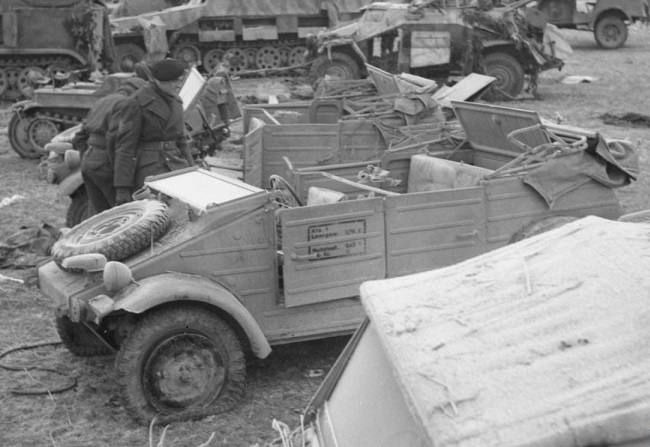
This photo shows the other side of the Kubelwagens in the above photo. In the foreground is a Sd.Kfz.2 better known as the Kleines Kettenkraftrad HK 101 or Kettenkrad.
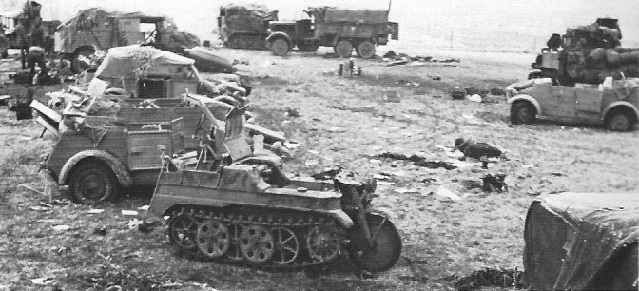
In this photo there is a Horch Kfz 15 command car, three leichte FH18 field guns and two motorcycles with sidecar. The motorcycle in the center is a BMW R4. Note the front of a jeep on the right edge of the photo.

Early in the morning on 24 December, panzers of Kampfgruppe von Cochenhausen moved west from their concentration point somewhere between Conjoux and Celles approached the junction of the Route d’Achene (N910) and Route de Neufchateau (N94) in Celles around 0600 hours. The leading Panther was disabled after running over a mine. Upon hearing the explosion, Marthe Monrique, the owner of the “Pavillon Ardennes”, turned on a light which alerted the Germans. A German officer questioned her about the road to Dinant and she told the officer that the road was mined by the Americans and was dangerous. Based on this false information, the column halted their advance towards the Meuse river. It did not really made a difference since the panzers were probably low or out of fuel and in a couple hours the Allied air forces would have attacked the panzers in the area.
Note: Some sources state that the Panther was disabled at the junction of routes N510 and N48 nearby Celles. That Celles is located in France and those two routes do not intersect.
The Panther was pushed off the road into the field next to the road rolling it over onto its turret and it remained in the field for sometime after the war. The US Army probably did tested anti-tank weapons on it.
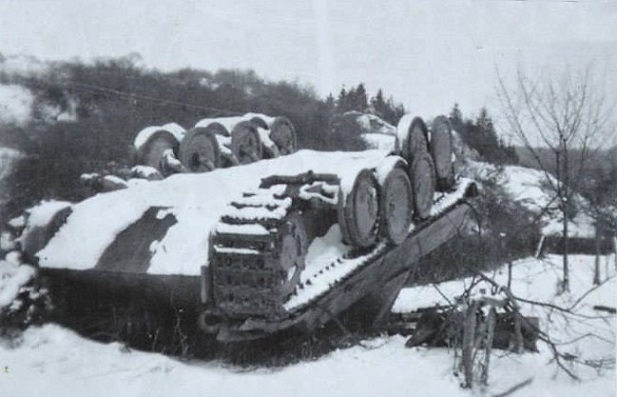
The tracks and road wheels were probably removed first in order to upright the Panther so it could be moved and then scraped. This uncaptioned photo found on the internet shows the Panther after it was up-righted. In this photo, the Panther still has the muzzle brake and the raised engine grill on the engine deck. Note the building in the background.
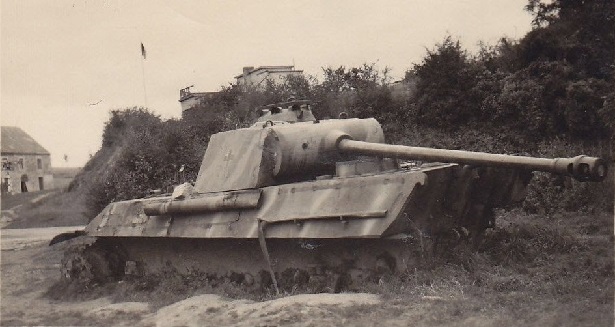
This is a later photo of the same Panther with the hatches, muzzle brake and raised engine grill removed. Compare this photo with the one above.
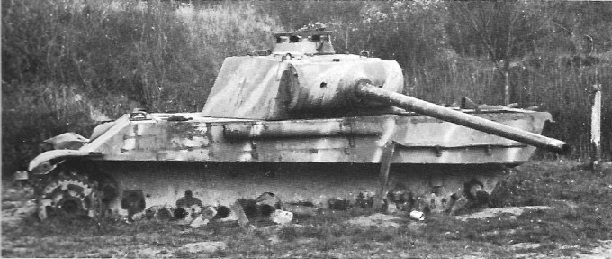
There is also a photo showing the front of the Panther in a field next to a Chateau. There is no chateau that resembles the one in the photo in the area today but it possible that it was torn down some time ago.
In 1948, Monrique rescued the Panther from the field and placed it next to the Cafe as a monument and a tourist attraction. Later the Cafe was renamed “Le Tank” and she became known as the “woman who had stopped the German tanks”.
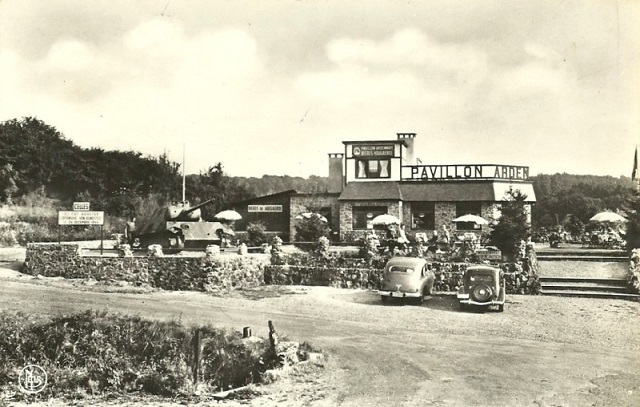
This is the same Panther today in Celles in front of now a Taverne and Grill named “Le Tank”.

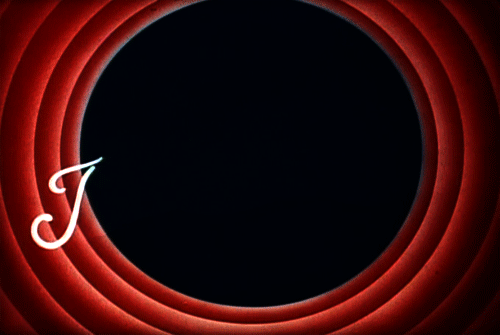
Only wanna state that this is handy, Thanks for taking your time to write this.
LikeLike
some truly interesting details you have written.
LikeLike
very good submit, i definitely love this web site, carry on it
LikeLike
Hi there! Such a great write-up, thanks!
LikeLike
Im grateful for the blog post.Really looking forward to read more. Want more.
LikeLike
Nice to see you have used my late fathers photo which you have no doubt sourced via the Internet – 3RTR Sherman with Lionel Whitcher peeking out of the turret.
LikeLike
Great work !
LikeLike
Celles, 24 Dec 1944 1625-1700 hrs
7 P-38s of 474th Fighter Group (9th USAAF) destroyed enemy trucks, tanks, 88mm S/P gun by strafing.
LikeLike
Wow, great blog.Thanks Again. Want more.
LikeLike
I just want to say thanks. Your article is very helpful for a scale model maker.
LikeLike
A great and informative site. I’m now building an Sd.Kfz 233 inspired by your research for a magazine. Thanks for posting.
LikeLike
Very interesting ! Thanks ! One question though: it just seems impossible that any Jagdpanther would have reached Foy by 24th in the morning. Any reliable source ?
LikeLike
Is it known who the commander was of the firefly was on the 24th who destroyed the ammo truck and the panzer 4?
LikeLike
My Grandfather Aubrey Harvey was a Trooper in the 29th Armoured Brigade and was killed 4th Jan 1945 in Givet – would you be able to give me any more information as to what he would be doing in the area? I know virtually nothing. Many thanks.
LikeLike
Great job
LikeLike
Very interesting info. I knew a german panzerveteran who disabled his tiger in the vincity of Celles during ‘wacht am Rhein’ when he ran out of fuel. Can it be this Tiger were the report from the 82nd Armored Reconnaissance Battalion AAR is speaking about? Does there exist pics of this Tiger? Who can help to clarify this story?
LikeLike
Hi, your work here is my ‘holy grail’…I own a schwimmwagen that a nearby (celles) family recovered in Jan 45 in Foy. They sold it to me in 1997. I have been looking for evidence of schwimmwagens in kg Bohm’ or kg Cochenhausen since then…your report here is stunningly thorough.
Do you have more pictures of the collection areas? I can’t ask you to do my work for me but where can I find the body of photos that you posted examples of? Thank you SO much for this exceptional work you did.perry kuehr. perrytyp166@gmail.com
LikeLike